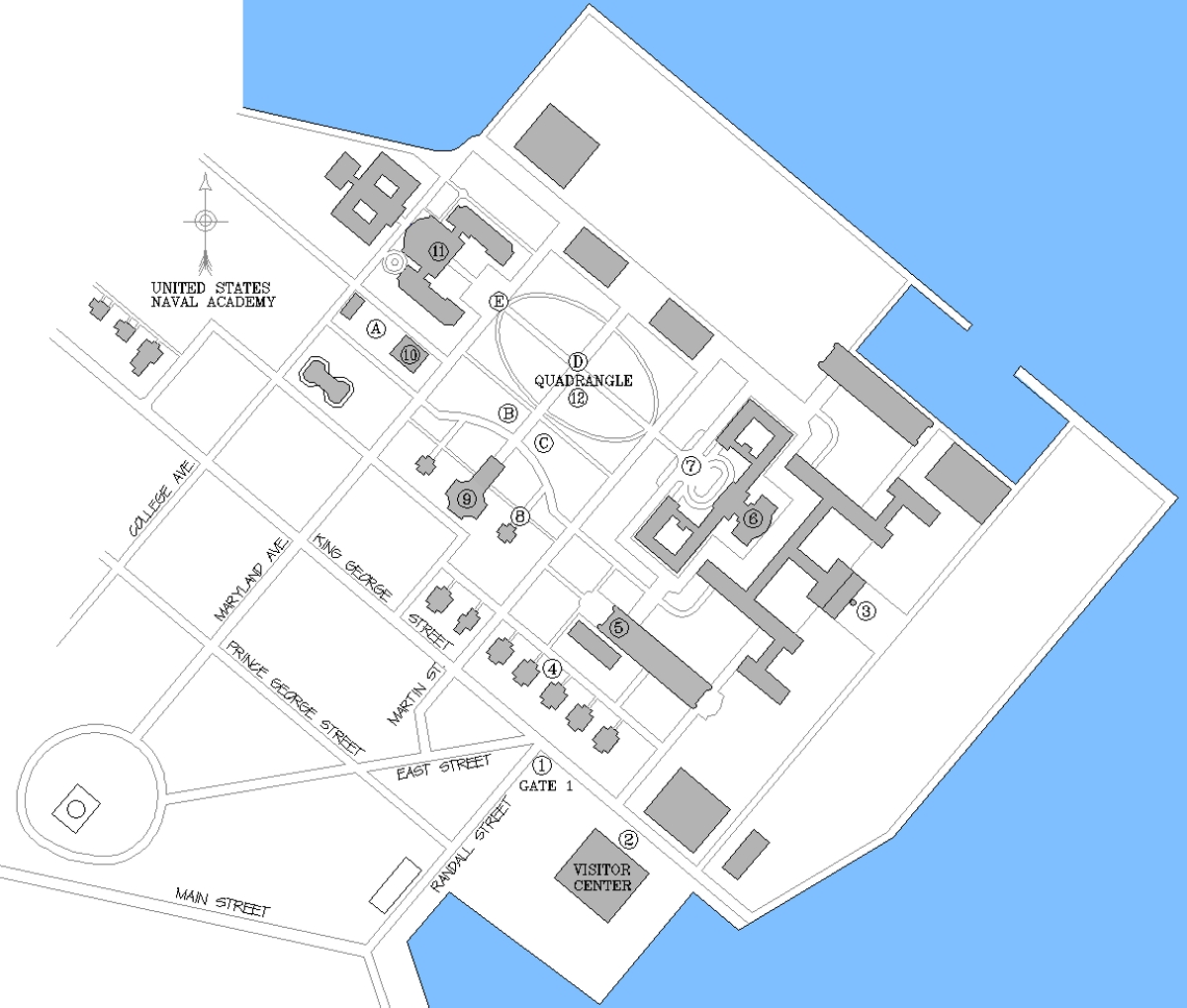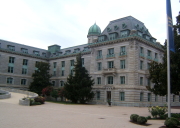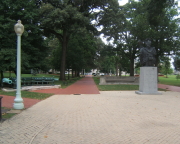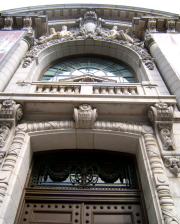United States Naval Academy Walking
Tour

Click here to download a printable version
of the U.S. Naval Academy Tour
Read our Annapolis Architecture
Guide article, THE
NAVAL ACADEMY AND ANNAPOLIS:
Baroque and Beaux Arts Architectural Neighbors, to learn more
about the architecture of the Naval Academy.
Start:
1. Gate
1, Randall Street & Prince George Street
The
U.S. Naval Academy campus is officially called "The Yard", a
term dating back to the Revolutionary War and originating from the word
"dockyard". Learn more about the Yard's conception and design by
clicking the Naval
Academy link at left in the navigation menu. **All
visitors to the Naval Academy must enter through the Visitor Access Center
at Gate 1. Everyone 16 and older must have a government-issued photo ID,
and only vehicles with USNA IDs or handicapped tags may enter the Naval
Academy grounds. 2.
Armel-Leftwich Visitor Center
The
Visitor Center is located in Halsey Field House. There is an information
center, tour guide service, exhibits, gift shop and snack bar. Visit the USNA
website for more information. **Walk
down Brownson Road to the Levy Center (on your left). 3.
Commodore Uriah P. Levy Center and Jewish Chapel
The
Levy Center contains a synagogue, fellowship hall, classrooms and offices.
It was designed by Joseph Boggs and completed in 2005. The chapel includes
a 45-foot-high wall that is a replica of the Western Wall in Jerusalem and
is made of Jerusalem stone. **Walk
back down Brownson Road, turn right on King George Street, turn right on Cooper Road, and
then turn left on Porter Road. 4.
Officer's Houses
These
houses are part of the original 1902 campus plan designed by Ernest Flagg. **Turn
right on Buchanan Road. 5.
Dahlgren Hall
Dahlgren
Hall, designed by Flagg and completed in 1903, was originally the armory.
It once housed an ice rink, and now contains offices and a large Assembly
Room. The Drydock Restaurant is housed in the
Northeastern end of the building and is open to the public.

Dahlgren Hall
6.
Bancroft Hall
Bancroft
Hall is home to the entire brigade of 4,000 midshipmen and is one of the
largest single dormitories in the world. The original building has been
expanded to completely fill the space between Dahlgren Hall, Macdonough
Hall (the original gymnasium) and Farragut Field (the original Parade
Ground). Designed by Beaux Arts trained campus architect Ernest Flagg, it features an heroic
entrance stair facing across the quadrangle to Mahan Hall. Note the
wonderful ornamentation including the battle ships plowing out of the roof
parapets. Visitors to Bancroft Hall can see the Rotunda, Memorial Hall,
and a mock-up of a typical midshipman's room.



Bancroft Hall
7.
Tecumseh Court
Tecumseh
Court is the site of noon meal formations for the brigade of midshipmen
and is named for its statue of Indian warrior Tecumseh, an 1817 figurehead
from the USS Delaware.

Tecumseh Court 8.
Buchanan House
Buchanan
House is the official residence of the Naval Academy Superintendent. It
was designed by Flagg, was the third structure to be built, and was named
in 1976 for the Naval Academy's first superintendent. 
Buchanan House
9.
Chapel & Crypt
The
chapel, also designed by Flagg, is given primary status in his campus
plan. It is the tallest building and placed on the highest ground. It was originally
axially opposite a ceremonial boat basin which unfortunately was filled in
and replaced with 1960's classroom buildings. The chapel is a masterpiece
of American Beaux Arts architecture. The
dome is based on the design of the 1708 Royal Chapel at Les Invalides in
Paris and the interior boasts windows designed by Tiffany Studios. The
towering bronze doors depict "father science" and "mother
patriotism" and were designed by Evelyn Beatrice Longman, a young
woman who won the design competition.


Chapel The
crypt of John Paul Jones, the father of the
American Navy and a Revolutionary War hero, was built in 1913. The design
was inspired by the 1840 bombastic imperial burial site of Napoleon
contained within the Royal Chapel in Paris. Jones' tomb is much more
modest, but still impressive. 10.
Preble Hall, USNA Museum
Preble
Hall houses the U.S.
Naval Academy Museum,
a collection of more than 35,000 items such as paintings,
prints and artifacts from naval history. Don't miss the 1951 Gallery of
Ships containing models dating back to the 17th century. Behind Preble
Hall is the Tripoli Monument
(A), the oldest military monument in the U.S.
It honors the heroes of the First Barbary War (1801-1805) and was carved
from Carrara marble in Italy in 1806. 11.
Mahan Hall
Mahan
Hall was designed by Flagg as the main classroom building. It includes
many features of Beaux Arts architectural principles. The symmetrical
entrance is raised a floor above grade with a bold double staircase. The
entrance axis is further emphasized by the clock tower, cupola, and
segmented round pediment. Sculptures of allegorical figures, repetitive
arches and a variety of pediments, brackets and balustrades complete the
complex yet tightly controlled composition. Note the wonderful
architectural hardware and lighting designed with nautical motifs.



Mahan Hall
12.
Quadrangle
The quadrangle is an
important organizing feature of the original 1902 campus plan. Today, it
contains many significant monuments to naval history. The
Herndon Monument (B), a tall grey obelisk erected in 1860, sits in front of the Chapel to the North.
It
commemorates Captain William
Lewis Herndon who went down with his ship (saluting in full dress
uniform), SS
Central America, rather than save
himself on September 12, 1857. The Herndon Monument is the site of the famous
"plebes-no-more" ceremony, where the plebes (first year students
at the academy) all work together to climb the greased monument and
replace a plebe's hat with an upperclassmen's hat at the top. The
Zimmerman Bandstand Gazebo (C), built in 1922 to replace an earlier gazebo,
sits in front of the Chapel to the East. It is named in honor of Charles
A. Zimmerman, composer of the Naval Academy's fight song, "Anchors
Aweigh". The
Mexican War Midshipmen's Monument (D), honoring midshipmen lost during that
war, is located at the center of the quadrangle. The
Macedonian Monument (E)
in front of Mahan Hall commemorates the capture of the
British frigate Macedonian by Captain Stephen Decatur on October 25, 1812.
|













